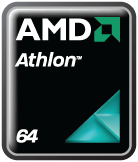Athlon 64 FX
 |
|
| Produced | From 2003 to present |
|---|---|
| Common manufacturer(s) |
|
| Max. CPU clock rate | 1.0 GHz to 3.2 GHz |
| HyperTransport speeds | 800 MT/s to 1000 MT/s |
| Min. feature size | 130nm to 65nm |
| Instruction set | MMX, SSE, SSE2, SSE3, x86-64, 3DNow! |
| Microarchitecture | K8 Microarchitecture |
| Cores | 1 |
| Socket(s) | |
The Athlon 64 is an eighth-generation, AMD64-architecture microprocessor produced by AMD, released on September 23, 2003. It is the third processor to bear the name Athlon, and the immediate successor to the Athlon XP. The second processor (after the Opteron) to implement AMD64 architecture and the first 64-bit processor targeted at the average consumer, it was AMD's primary consumer microprocessor, and competes primarily with Intel's Pentium 4, especially the "Prescott" and "Cedar Mill" core revisions. It is AMD's first K8, eighth-generation processor core for desktop and mobile computers. Despite being natively 64-bit, the AMD64 architecture is backward-compatible with 32-bit x86 instructions. Athlon 64s have been produced for Socket 754, Socket 939, Socket 940 and Socket AM2. The line was succeeded by the dual-core Athlon 64 X2 and Athlon X2 lines.
The Athlon 64 was originally codenamed ClawHammer by AMD, and was referred to as such internally and in press releases. The first Athlon 64 FX was based on the first Opteron core, SledgeHammer. Both cores, produced on a 130 nanometer process, were first introduced on September 23, 2003. The models first available were the FX-51, fitting Socket 940, and the 3200+, fitting Socket 754. Like the Opteron, on which it was based, the Athlon FX-51 required buffered RAM, increasing the final cost of an upgrade. The week of the Athlon 64's launch, Intel released the Pentium 4 Extreme Edition, a CPU designed to compete with the Athlon 64 FX. The Extreme Edition was widely considered a marketing ploy to draw publicity away from AMD, and was quickly nicknamed among some circles the "Emergency Edition". Despite a very strong demand for the chip, AMD experienced early manufacturing difficulties that made it difficult to deliver Athlon 64s in quantity. In the early months of the Athlon 64 lifespan, AMD could only produce 100,000 chips per month. However, it was very competitive in terms of performance to the Pentium 4, with magazine PC World calling it the "fastest yet". "Newcastle" was released soon after ClawHammer, with half the Level 2 cache.
...
Wikipedia
